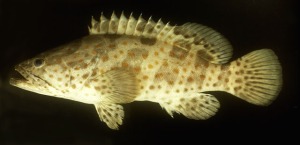
Milkfish Fry (Chanos chanos) = typically 17 days old
Tiger Grouper (Epinephelus Fuscoguttatus) = 7 – 8 CM – fast grower,
very popular !
Competitive prices direct from the supplier !
Minimum order is 500 KG and we only accept prepayment prior to shipment only.
To expedite price quotation, please indicate the destination where you want the fries to be ship to your port destination
Please contact us for information at:
KAWAN ABADI AQUACULTURE
Cell/Text Msg: 62-856-3749619
Fax: 62-362-94647 email sales
Milkfish (Chanos Chanos)
Biology
Our company in Bali, Indonesia has developed broodstock and hatchery technology to reduce the rather destructive fry fishery, and to improve yields in milkfish ponds.
Broodstock management
Seed production
Hatchery techniques are refined continually. Rotifer ingestion and growth and survival of milkfish larvae are higher in black-painted tanks than in tan-painted tanks. A nutritionally balanced and cost-effective formulated diet for milkfish larvae is a combination of rotifers starting day 2 or day 8, and may be used as sole feed starting day 15.
Farming
Feeds for milkfish fry must contains about 9% lipid (cod liver or coconut oil); growth and survival of fry are higher at lower salinity. For milkfish in semi-intensive ponds, it is more cost efficient to give 24%-protein diet with balanced amino acids at a feeding rate of 4% of body weight daily, but supplemental feeding should not exceed 38 kg/ha-day to maintain good water quality.
GROUPER
Full-cycle aquaculture (the use of hatchery-reared fingerlings) of many grouper species is becoming more common throughout Asia. Grouper are cultured at various scales in every country of Southeast Asia – Hong Kong, Indonesia, Malaysia, Philippines, Taiwan, Thailand and Vietnam. While currently making up only about 10–15 per cent of the total trade, there is an increasing supply of full-cycle, cultured fish. The most importantsource countries are Taiwan, Indonesia and Thailand. Grouper culture is also ongoing in Australia andthe People’s Republic of China, although the industry in these countries will not be discussed here.
Grouper culture is expanding in many areas of Indonesia. While there is no statistical data available on grouper culture in Indonesia, national aquaculture statistics show brackish water and cage culture growing at 8 and 16 per cent, respectively, during the 1990s. The primary areas for grouper grow-out culture in Indonesia are Aceh, north Sumatra (Nias and Sibolga), Riau Islands, Bangka Islands, Lampung, west Java,KarimunjawaIslands(centralJava), Teluk Saleh (west Nusa Tenggara), south Sulawesi, north Sulawesi and southeast Sulawesi. Grouper culture is generally characterised in Indonesia by the use of wild-caught seed and use of trash fish for feed. There is limited use of hatchery-reared seed, although this is growing.
Grouper are primarily grown-out in net cages. There is some limited pond grow-out culture, particularly for small size classes, but a general shortage of land for ponds has been identified (Sadovy 2000).
Some private hatcheries have succeeded in seed production, applying technologies learned from the Gondol station. In addition, humpback grouper seed has been provided from the station to many aquaculture operations in Bali and elsewhere in Indonesia and Southeast Asia for grow-out. The Gondol station has also succeeded in full-cycle culture of E. fuscoguttatus. The spawning period for this species in the hatchery has been found to be very short, only three to four days a month, and not all year round. Survival rates are low due to high levels of cannibalism, although survival rate and growth rate in cages is high. Many of the hatcheries in Bali culture several species of fish in addition to grouper such as sea bass, milkfish and humphead wrasse (Cheilinus undulatus).
This species is in the family of Serranidae (sea basses: groupers and
fairy basslets).
Subfamily of Cromileptes
The Panther Grouper is pale greenish brown to whittish brown, with widely-spaced, round, black spots on head. body and on all fins. Few faint blotches scattered on, and overlapping with small black spots on body.
Maturity size is 39 cm or 15.6 inches with a maximum size of 70 cm or 28 inches.
This fish prefer to live close to coral reef areas.
Occurs in Eastern
Indian Ocean. Indo-Australian islands, China Sea, islands of the Philippines,
reefs of the Western coast of Australia, Melanesia.
Tiger Grouper – Epinephelus Fuscoguttatus
This species is in the family of Serranidae (sea basses: groupers and
fairy basslets).
Subfamily of Epinephelinae.
Order of Perciformes (perch-likes).
Class of Actinopterygii (ray-finned fishes)
and sides. The head, body and fins have small dark spots. There is a dark spot on the caudal peduncle
This marine fish prefer to live close to reef-associated surrounding with a depth range of 1 – 60 meters or 2.2-132 feet. The fish tolerate tropical water ranging from 35 degree North to 35 degree South from the Equator.
Minor commercial use in fisheries as well as commercial aquaculture. The smaller sizes are for uses in the aquarium trade. It can double in size in 1.4-4.4 years.Occurs in the Indo Pacific from the Red Sea, along the east coast of Africa to Mozambique, east to Samoa and the Phoenix Islands, north to Japan and south to Australia.
